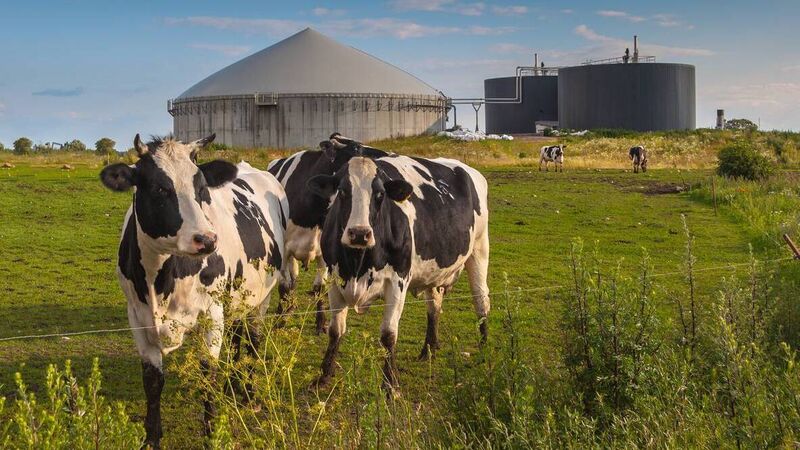3% of Ireland's farmland and 1.3m cattle needed to meet AD target

It's expected around 20 large-scale anaerobic digesters will be built in Ireland by 2025, and up to 200 by 2030.
Just 3% of Ireland's agricultural land would be needed for grass to meet the biomethane target set for 2030.
A bigger challenge than finding the 120,000 hectares of grass for biodigesters is likely to be sourcing winter slurry from the equivalent of 1.3 million cattle, according to JJ Lenehan of Teagasc, speaking in a recent Teagasc Signpost event online.
Dr Tom O'Dwyer, Head of the Signpost Programme, was joined by Teagasc Energy and Rural Development Specialist Barry Caslin, and Mr Lenehan, to discuss the biomethane opportunities.
Mr Lenehan said large beef-finishing enterprises where cattle are kept indoors, or piggeries, could be ideal locations for biodigester plants, especially in areas with considerable potential for increased grass production.
He suggested: “If we do have to reduce animal numbers because of greenhouse gas emissions, production of forage for anaerobic digestion [AD] is a relatively easy practical solution for farmers to reuse their land”.
Biomethane is a carbon-neutral renewable gas made from crops (including grass), slurry, manure, and food waste, in the AD process. The feedstock can be any organic non-woody material which is converted by micro-organisms into biogas and digestate, in the absence of oxygen.
The "raw" gas containing about 55% methane is called biogas. When upgraded to 97% methane, it is called biomethane. The digestate residue is a valuable fertiliser.
“The studies have shown that grass is the feedstock for Ireland”, said Mr Lenehan. “The crop of choice would be grass”.
Teagasc’s research has demonstrated that up to 12 tonnes of grass dry matter can be produced in Ireland. But the average production is only five tonnes.
Farmers with low stocking rates could be incentivised to produce grass for biodigester plants.
Research by Dr Ciara Beausang on the sustainability of biomethane production in Ireland demonstrated that 10.77 tonnes of dry matter per hectare could be produced with a perennial ryegrass and clover sward; or 11.68 t/ha with a more mixed sward of Timothy, perennial ryegrass, red clover, ribwort plantain and chicory, with no added nitrogen in either instance.
The issue of unintended consequences of reduced biodiversity was raised, if increased production of grass for AD plants was incentivised on currently low-intensive farm areas.
Barry Caslin responded that production for biomethane must adhere to the EU Renewable Energy Directive. Any AD plant must attain strict sustainability targets for zero-carbon renewable fuels.
For example, land that was formerly peatland, land of a high biodiversity value, or land with a high carbon stock, cannot be used to grow feedstock for AD.
They are designated as Class 2 animal by-products and require thermal treatment and volume reduction, with associated capital investment costs. The exception is small volumes of slurry from a single farm (less than 5,000 tonnes of fresh material per year) processed on-farm in a small-scale biogas plant.
Poultry manure or broiler litter can be used as AD feedstock, but because of the high nitrogen content, additional feedstocks are needed for optimal nitrogen–carbon balance.
Policies are currently under preparation in Ireland which, it is believed, will provide aid for capital investment in AD plant construction (buildings and equipment), as well as aid linked to the amount of biogas produced.
“Customers are looking for biomethane across Europe”, said Mr Lenehan. But economic viability is fundamental to success in developing biomethane in Ireland, he added.
Natural gas (fossil fuel) contributed 31.3% to energy generation in Ireland in 2019, and remains at approximately that level. The Sustainable Energy Authority Of Ireland has indicated that biomethane could replace 25% of Ireland's fossil fuel gas supply, with forage-based feedstock contributing most to this (over 40%), and waste only 5%.
The Irish biomethane targets are challenging, and will require appropriate policies and incentives to be put in place.
The benefits of developing a biomethane industry include increased energy security, organic waste processing, reduction of synthetic fertiliser use, provision of biogenic carbon dioxide to industry, job creation, and reduction of greenhouse gases.
“Digestate is a potent fertiliser,” said Mr Lenehan, who explained that it contains N, P and K, which are not removed during biogas production.
"Digestate can be spread in liquid form (by trailing shoe or direct injection) or processed and the individual nutrients segregated out. The nitrogen is in ammonia form in the digestate and hence, will be readily available in the soil."
Biomethane from grass compares well with some other energy crops, with German research showing that the output of biomethane from grass (per hectare) far exceeds biodiesel from oilseed rape, or bioethanol from wheat.










